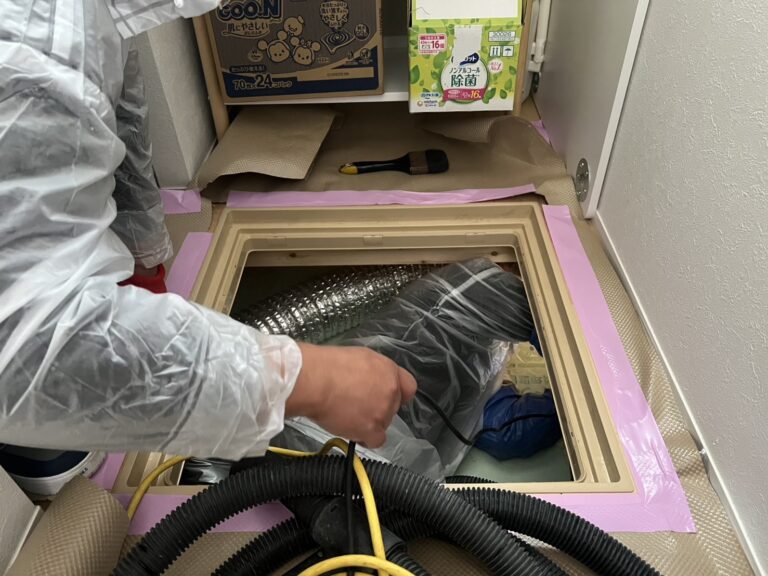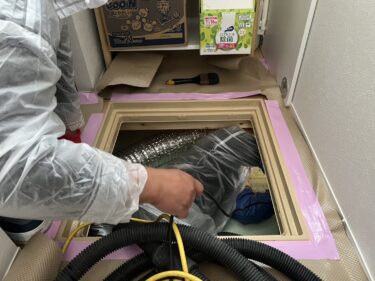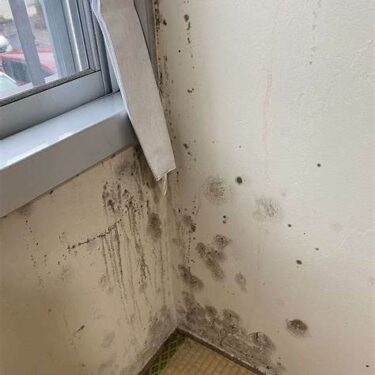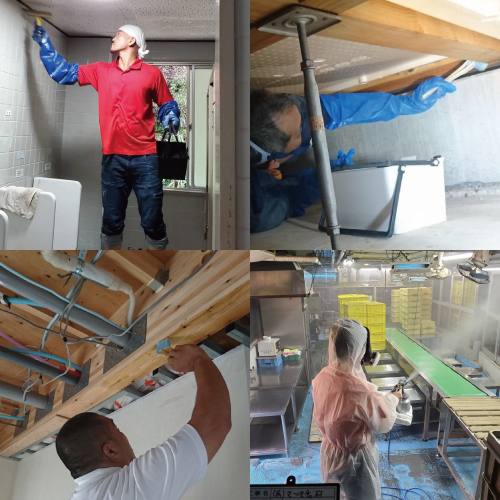Raising the issue
Condensation and moisture near the window causes mold to pop up on the curtains…. Not only does it look bad, but the mold spores scatter throughout the room, spreading health concerns.
What you will learn from reading the article
This article explains how to safely remove mild to severe mold from curtains at home and provides detailed information on how to remove mold from clothing and how to prevent its recurrence.
Benefits of reading the article
The article provides a wealth of easy-to-practice steps that even novice cleaners can follow, and it also covers colored and patterned curtains and delicate materials.
1. Why Do Curtains Grow Mold?
Mold on curtains isn’t just caused by lack of cleaning. It can happen to anyone depending on their living environment and daily habits. Curtains near windows are particularly vulnerable due to frequent exposure to moisture and condensation.
1-1. The Effects of Condensation and Humidity
One of the main causes of mold on curtains is moisture from condensation or indoor humidity. Window glass easily collects water due to temperature differences, and that moisture transfers to the curtains. Mold thrives in this damp environment and spreads quickly, especially during winter or rainy seasons.
1-2. Why Dirty or Dusty Curtains Attract Mold
Curtains covered in dust or grease can feed mold. Oil from cooking, airborne dust, and skin oils can stick to the fabric and become nutrients for mold. Even if curtains look clean, they might harbor mold, making regular cleaning essential.
2. Easy Ways to Remove Light Mold at Home
If you catch mold early, it’s possible to remove it safely at home using common household items. This section introduces safe techniques to clean mold without damaging your curtain fabric.
2-1. Using Neutral Detergent and a Brush to Gently Tap Off Mold
For light mold, dilute neutral detergent in water and apply it to the moldy area. Tap the fabric gently with a soft brush to lift the mold. Avoid scrubbing too hard to prevent fabric damage. Wipe off the detergent thoroughly with a damp cloth afterward.
2-2. Soaking Curtains in Oxygen Bleach or Baking Soda
For slightly tougher mold, soaking the curtains in a mix of warm water and oxygen bleach or baking soda is effective. Let the fabric soak for about an hour, then rinse well and hang dry in a shaded area to finish.
3. How to Deal With Stubborn Black Mold
Black mold tends to penetrate deep into the fabric, making it hard to remove. Using the correct type of bleach and following the right procedures is crucial to clean thoroughly without damaging the curtain.
3-1. Steps for Using Chlorine Bleach
Chlorine bleach works well on black mold. Apply a diluted solution directly to the mold, leave it for 15–30 minutes, then rinse thoroughly and hang to dry. Use it only on white or light-colored curtains, as it may cause discoloration.
3-2. Cautions When Using Chlorine Bleach on Patterned Curtains
Chlorine bleach may cause fading on colored or patterned curtains. Test on a hidden area first or consider switching to oxygen bleach. Always rinse well and limit exposure time to protect the fabric.
4. How to Wash Machine-Washable Curtains
If your curtains are machine-washable, cleaning them at home can be easy. However, improper handling during washing or drying can damage the fabric. This section covers the right way to do it.
4-1. Washing With Detergent and Bleach
Check the care label first. Use a laundry net, combine neutral detergent and oxygen bleach, and wash on a gentle cycle. This allows effective mold removal without harming the curtain fabric.
4-2. Tips for Drying Curtains
Use a short spin cycle and hang the curtains back on the rail while still damp to prevent wrinkles. Avoid using a dryer, as the heat may cause shrinkage or damage. Ensure the room is well-ventilated to help them dry evenly.
5. How to Handle Non-Washable or Delicate Curtain Fabrics
Some curtains made of lace, silk, or other delicate materials cannot be washed in a machine. In such cases, alternative care methods are required to prevent damage.
5-1. Gentle Hand Washing and Air Drying
Hand washing is suitable for some delicate fabrics. Soak the curtain in lukewarm water with neutral detergent and gently press-wash. Rinse thoroughly and air dry in the shade without spinning or wringing.
5-2. When to Call a Professional Cleaner
If you’re unsure about the material or the mold has spread extensively, it’s safest to hire a professional curtain cleaner. They can clean thoroughly without causing color loss or fabric damage.
6. Don’t Forget to Check Mold on Clothes Too
If your curtains have mold, your clothes may also be at risk, especially if stored in humid closets. Preventing re-contamination means cleaning affected clothing alongside your curtains.
6-1. Treating White and Red Mold With Bleach
Oxygen bleach is safe for removing white or red mold from clothes. Soak in warm water with bleach for about an hour, then wash as usual. It’s especially effective on white clothing.
6-2. Using Oxygen or Chlorine Bleach on Black Mold
Black mold requires stronger treatment. Use oxygen bleach for colored clothes, and chlorine bleach only for whites. After washing, dry clothes in the sun or use a dryer to remove lingering moisture.
7. Daily Habits to Prevent Mold Regrowth
Even after cleaning, mold can return if the environment isn’t improved. Consistent habits like proper ventilation and humidity control can significantly reduce mold risks.
7-1. Let Air Flow Between the Curtain and Window
Avoid letting curtains stick to the window glass. Create a small gap to allow air circulation. This prevents condensation buildup and helps keep mold at bay.
7-2. Regular Ventilation and Humidity Control
Open windows regularly to allow airflow. Use a dehumidifier or air circulator to maintain humidity below 60%. These small habits make a big difference in mold prevention.
8. Use Alcohol and Natural Cleaners as Alternatives
For those avoiding commercial mold removers, alcohol and natural substances like baking soda and citric acid can be effective for light mold or prevention.
8-1. Alcohol Treatment for Light Mold
Use ethanol on a cloth to gently wipe mold spots. It evaporates quickly, leaving no moisture behind and causing minimal damage to fabric. Be careful not to use it near flames.
8-2. Cleaning With Baking Soda and Citric Acid
Mix baking soda and citric acid to create a foamy cleaner. Spray it on moldy areas, let it sit for a few minutes, and wipe clean. It’s safe for homes with children and pets.
9. Health Risks of Mold and Safety Tips
Leaving mold untreated can affect more than just your home’s appearance. It poses real health risks, especially to children, seniors, or those with respiratory issues.
9-1. Allergies and Respiratory Problems
Mold spores can float through the air and trigger allergies, asthma, and other respiratory conditions. Sneezing, coughing, and itchy eyes may indicate mold exposure.
9-2. Safety Gear and Ventilation During Cleaning
Always wear gloves and a mask while cleaning mold. Keep windows open to ensure ventilation, especially when using strong cleaners like chlorine bleach to protect your lungs and skin.
10. When to Ask a Professional for Help
In some cases, home treatment isn’t enough. If mold has spread widely or the fabric is delicate, it’s better to consult professionals.
10-1. When Black Mold Has Spread Over a Wide Area
If mold has reached the walls, floor, or other surfaces, it may be widespread behind the scenes. A professional can thoroughly inspect and treat the entire affected area.
10-2. When You’re Concerned About Fabric Damage or Fading
For delicate or expensive curtains, improper cleaning may cause irreversible damage. Professionals have the tools and experience to treat mold while preserving fabric quality.
Mold Removal and Mold Remediation: Mold Busters Osaka and Mold Remodeling Tokyo/Nagoya
Mold Busters Osaka and Mold Remodeling Tokyo/Nagoya aim to solve the root cause of curtain and indoor mold problems with their reliable technologies. These are specialized services provided by Taikoh Kenso Co., Ltd. that use the unique MIST Method®, which is a world apart from other companies, to remove mold without damaging the material.
The greatest feature of the MIST Method® is that mold can be decomposed and removed by a special agent without scraping or rubbing. It is gentle to all materials, including wood, delicate curtain materials, and wallpaper, and yet it demonstrates a high level of fungicidal power. In addition, spraying a mold inhibitor after treatment provides excellent prevention of recurrence and long-term peace of mind. The system is also safe for human health, and can be used by households with small children or the elderly.
Furthermore, Taikoh Kenso Co., Ltd. does not stop at mold removal, but has the advantage of being able to handle interior and exterior remodeling as a single service. For example, our professional staff can provide comprehensive support for requests such as “I want to replace the wallpaper after removing the mold,” or “I want to remodel the floors and ceilings as well. Not only does this save the time and effort of requesting separate contractors for remodeling and mold removal, it also leads to the integration of construction and cost optimization.
In the remodeling business, we handle remodeling of detached houses, condominiums, stores, and offices, offering planning that combines design and functionality. In particular, we have an established reputation for creating spaces that work in tandem with mold remediation, such as “moisture-resistant materials” and “mold-resistant design.
Moldbusters Osaka, Mold Remodeling Tokyo and Nagoya, and Taikou Kenso Co., Ltd. are the best partners for those who wish to have mold removed and a home that will not reoccur. If you are not looking for a temporary solution to your mold problem, but rather a fundamental improvement and reconstruction of a comfortable living space, please contact us for a consultation.





